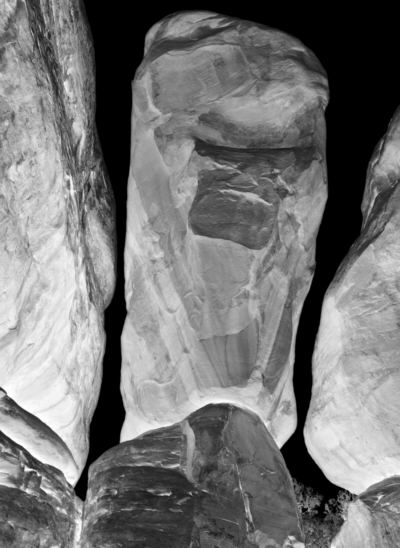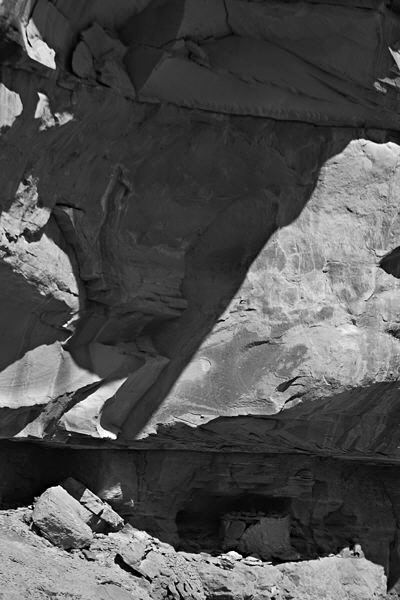Posted by Steve Durbin on May 8th, 2007

On my way to Anasazi country recently, I stopped at Arches National Park, where I stayed the night. Next morning before dawn, I was off to an area known as the Devil’s Garden, which I had never visited. It turned out to be one of the weirdest landscapes I’ve ever seen: a few trees and other plants sprinkled among mostly bare reddish sandstone, eroded into bizarre shapes determined partly by crack systems. Although the day before I had ignored the more famous features, I immediately got to work making pictures. Almost as quickly, the metaphor of bones came to me. These rocks were like internal structural elements somehow made visible at the surface. I knew the series would have to be titled Bones of the Earth.
more… »
Posted by Richard Rothstein on May 6th, 2007

Last week I postulated that Art Deco as an art movement speaks a distinctly queer language. This week The New York Times asks how openly and assertively gay artists reflect the emergence of gay culture into the mainstream. It’s a fascinating article that speaks very much to the issue of how art both reflects and influences cultural change. While words are one thing, the work itself goes a lot further in answering the questions. What is gay art? What is it reflecting? How is it reflecting and changing gay culture and the culture at large? Rather than talk about the work of the artists discussed in today’s Times, I attempted to visually represent the leading edge of this supposed new school of art. As a gay man I am of course fascinated by this work and its collective messages, but I’m more curious to know what straight men and women think. However, while I look forward to your opinions I would also postulate that even those of you who are “straight” are, as artists, absolutely queer as well, regardless of who you bed so I’m not really sure you can provide a “straight” perspective…nonetheless…


 more… »
more… »
Posted by Steve Durbin on May 1st, 2007

I’ve just returned from my trip to Utah in pursuit of earlier denizens, the Anasazi. Like the proverbial tourist, I won’t know what it was like until I’ve seen my pictures. Not because I never took my camera from my eye — it was there less than 1% of the time — but because the trip is not over yet. I’m done exploring the canyons for now, but I’ve just begun to explore the latent content of my experiences and the images captured by my camera. That will take longer, and I know there’s plenty of discovery still to happen. Nevertheless, one idea can be identified that is not entirely a surprise.
more… »
Posted by Richard Rothstein on April 29th, 2007

Are the Empire State Building and the Golden Gate Bridge queer?
In response to my “tribute” to the Empire State Building, Karl asked a simple question that caused me to do an extraordinary amount of thinking. This post is the answer and it’s hardly a simple one.
I was gushing over my life-long fascination and love affair with the Empire State Building and its powerful iconic nature. Karl asked: “How much of your attraction to the building has to do with the architectural style itself? At first I couldn’t’ see how to separate the two but after a while it dawned on me that there was much more to the question than was immediately apparent.
more… »
Posted by Richard Rothstein on April 22nd, 2007
EXODUS 20:2-14: “You shall have no other gods before me. You shall not make for yourself an image, whether in the form of anything that is in heaven above, or that is on the earth beneath, or that is in the water under the earth. You shall not bow down to them or worship them; for I the Lord your God am a jealous God, punishing children for the iniquity of parents, to the third and the fourth generation of those who reject me, but showing steadfast love to the thousandth generation of those who love me and keep my commandments.

I’m fascinated by the relationship between secular and religious iconography. In particular, I have an intensely passionate emotional and intellectual relationship with one of the world’s most compelling and famous secular icons: the Empire State Building and it is through that passion that I’ve come to understand something more about religious iconography.
When it comes to religious iconography I am seriously handicapped as an agnostic, a cynic and as a Jew. This subject is particularly challenging for a Jew, secular or otherwise. Even a secular Jew grows up “understanding” that iconography is simple-minded at best, blasphemous at worst. The truth is found within our hearts and minds and to seek the truth through images is false, intellectually lazy and in opposition to the absolute word of God.
But my life long relationship with the Empire State Building has defied my Jewish perspective and seditiously lured me into the world of image worship. (Just one of the commandments I routinely break.) more… »
Posted by Doug Plummer on April 17th, 2007
 I had a very successful Photo Lucida with my contra dance project. The consensus after 4 days of reviews, with some of the top people in the photography fine-art field, is that the project has legs and great potential. Now I need to name it.
I had a very successful Photo Lucida with my contra dance project. The consensus after 4 days of reviews, with some of the top people in the photography fine-art field, is that the project has legs and great potential. Now I need to name it.
Alec Soth has a post today on book titles. He loves pondering them, feels they define and sum up the nature of a work, and that they can make or break the success of a book.
I am considerably less gifted in this realm, despite my usual felicity with words. I am struggling to come up with an all-encompassing, pithy and memorable title for my contra dance project.
“Contra Dance in America: A Photographic Journey” is accurate, but really boring. My other working title, “Unconfined Joy,” is from the over-quoted Lord Byron poem, which goes,
On with the dance! let joy be unconfined;
No sleep till morn, when Youth and Pleasure meet
To chase the glowing hours with flying feet.
~George Gordon, Lord Byron, Childe Harold’s Pilgrimage
Any ideas out there? Here’s the link to my “yes-it-really-needs-updating” dance page. You can also look through the blog posts from Photo Lucida.
Posted by Richard Rothstein on April 15th, 2007

From today’s New York Times “Digital manipulation is just another tool. It’s less profound than the lens you use, or the angle. But in the end, photography is all about manipulation, and as it’s evolved, it’s become more manipulative in every way. I’ve never seen photography as a truthful medium. It’s about individual perceptions of reality, and that’s what people want to see.”
The Times examines the work of London photographer, Nick Knight. “When I’m producing a piece of work,” Knight says, “I’m looking for something I haven’t seen before, and once I’ve produced it, I’ll want to see something else.”
One of the world’s most successful fashion photographers, Knight lives in the digital world.
I realized that one of the most fascinating and potentially controversial and engaging aspects of digitally enhanced photography is that unlike any other visual art form before it, just about anyone with a computer can have at it. A great artist’s work (assuming you accept Knight as a great artist) becomes an interactive experience that can evolve, devolve and easily change according to the viewer’s own vision. Imagine a visual art form that is a photograph or creation that is the combined effort and vision of both the artist and the viewer(s). Warhol’s multiple images reimagined except the series is the work of the original artist digitally “enhanced” infinitely by his viewers. more… »








 I had a very successful
I had a very successful 